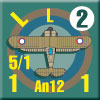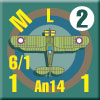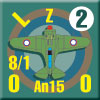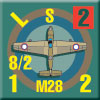The Cruel Sea:
Russia’s Airplanes
by Mike Bennighof, Ph.D.
August 2024
 In our Second Great War alternative history story line, the First World War ended in late 1916. That saved millions of lives, several Imperial thrones, and a great deal of economic devastation. It also seriously altered the arc of technological development, as heavier-than-air flight (you know, airplanes with wings) received less attention than lighter-than-air craft (that is, zeppelins). In our Second Great War alternative history story line, the First World War ended in late 1916. That saved millions of lives, several Imperial thrones, and a great deal of economic devastation. It also seriously altered the arc of technological development, as heavier-than-air flight (you know, airplanes with wings) received less attention than lighter-than-air craft (that is, zeppelins).
Second Great War at Sea: The Cruel Sea is intended as both an expansion set for Bismarck and Arctic Convoy, turning those two games into a gigantic naval game of alternative history (and massive battleship action), but also as a toy box for other expansions. The aircraft pieces, generic small warships and markers will also be used in other expansions, like Swedish Steel or Sword of the Sea, so we can include more new ships and planes there. That makes for more fun in the box.
As we see in Second Great War at Sea games and expansions like The Cruel Sea, aircraft development in this alternative world that never happened is about a decade behind that of our own history, give or take a little. Advanced biplanes and early monoplanes are the technological standard, with designers testing out the size limits imposed by material strength and engine power. The advanced engines and aerodynamics of the Spitfire, Mustang and Zero still lie in the future, while the gently floating airship and the helicopter have reached a standard about a decade ahead of our actual history.
 That makes for a very different sort of warfare, not quite to Jules Verne standards but not like that of our own world, either - I never wanted the Second Great War games to be just like the real thing but with different-colored pieces. Battleships rule the seas and airships rule the skies, which also allows for a level of command, control, communications and intelligence that our own world would not see until the advent of satellite data links. That makes for a very different sort of warfare, not quite to Jules Verne standards but not like that of our own world, either - I never wanted the Second Great War games to be just like the real thing but with different-colored pieces. Battleships rule the seas and airships rule the skies, which also allows for a level of command, control, communications and intelligence that our own world would not see until the advent of satellite data links.
Imperial Russia in our story is a relative hotbed of both fixed-wing and rotary (helicopter and autogiro) flight development. While there are many manufacturers, most military heavy aircraft (bombers and transports) come from Igor Sikorsky’s Russo-Balt Works. Fighter planes are the specialty of the Anatra Works, based in Odessa.
Daily Content includes no AI-generated content or third-party ads. We work hard to keep it that way, and that’s a lot of work. You can help us keep things that way with your gift through this link right here.
In our own history, Anatra built reconnaissance planes during the First World War and designed a promising fighter variant. After the plant was nationalized by the Bolsheviks, its workers were so filled with joy at the thought of laboring for a state-owned enterprise that they burned to factory to the ground, and that was the end of the Anatra Works.
 The Anatra Works is a prosperous private firm in the world of the Second Great War, turning out fighter planes for the Imperial Air Force and a series of popular sporting planes for the commercial market. Most of its designs come from the Tupolev design bureau the favorite of the Imperial Air Force. The Anatra Works is a prosperous private firm in the world of the Second Great War, turning out fighter planes for the Imperial Air Force and a series of popular sporting planes for the commercial market. Most of its designs come from the Tupolev design bureau the favorite of the Imperial Air Force.
The oldest fighter in the Russian inventory is the An12, a biplane with good maneuverability armed with a pair of machine guns. Design work began under the supervision of Andrei Tupolev, with Pavel Sukhoi serving as lead designer. The plane used an imported Bristol Jupiter engine, and carried its weapons in the fuselage where they fired through the propeller. The little biplane could also carry a light bomb load. Just over 800 of them were manufactured, and they became the standard Russian fighter plane.
Note: “An12” was the original designation of the plane that became the Polikarpov I-5 and served the Red Air Force in the early 1930’s. Remaining planes were brought out of storage in 1941 and used as ground-attack craft in the early months of the Great Patriotic War. Production figures are for the Soviet I-6.
An12 production ended in 1936, replaced on the assembly line by the An14. The An14 had the same armament as the An12 and much the same performance except for slightly better range. Like the An12 it could also be used for dive bombing, though it rarely performed in this capacity.
Note: Our An14 is a slightly modified version of the Soviet Polikarpov I-6.
 Like those of other nations, the largest Russian airships carried a small air group of fighters for protection. The standard Russian airship fighter is the An15, a radical new design by Pavel Sukhoi under Tupolev’s direction. The low-wing monoplane carries a pair of machine guns in the fuselage, and is not fitted to carry other ordnance since Russian airships lack magazines for such. Like those of other nations, the largest Russian airships carried a small air group of fighters for protection. The standard Russian airship fighter is the An15, a radical new design by Pavel Sukhoi under Tupolev’s direction. The low-wing monoplane carries a pair of machine guns in the fuselage, and is not fitted to carry other ordnance since Russian airships lack magazines for such.
Note: Our An15 is a modified version of the Soviet Polikarpov I-16, lightened for airship duty with the 20mm cannon in the wings and bomb racks deleted.
The Imperial Russian Navy also relies on seaplanes for reconnaissance missions, with the Shchetinin firm of St. Petersburg still making the successful M (Marine) series of the First Great War. D.P. Grigorivich designed the M-series flying boats flown by the Imperial Navy during the war, and after the Russian Civil War he continued his work for the Soviet Union.
 The M22 is a development of the M-series flying boats stretching back to the M9 of 1915. It’s a slow but reliable boat with good range, carrying a single machine gun for self-defense and a light load of bombs. The M22 is a development of the M-series flying boats stretching back to the M9 of 1915. It’s a slow but reliable boat with good range, carrying a single machine gun for self-defense and a light load of bombs.
Note: The actual M22 was only a prototype, one of many designs built and flown by Grigorivich in the mid- to late-1920’s.
Its successor is the M28, designed by G.M. Beriev. It was a high-wing monoplane flying boat, with outrigger floats for added stability like most aircraft of its type, and its engine carried in a pod over the fuselage. Known to its pilots as the Korova, or “cow” for its handling characteristics, it was a rugged plane with good range with a pair of dual machine guns for defense and a good bomb load. It also served very well on anti-submarine duties. The Imperial Navy ordered over 1,000 machines and used them in all theaters.
 Note: The M28 is based on the Beriev MBR-2, enlarged to allow a stronger defensive armament and larger bomb load. The standard Soviet flying boat of World War II, it had no outstanding qualities other than its quantity, with over 1,300 of them built, which is a quality all its own. Note: The M28 is based on the Beriev MBR-2, enlarged to allow a stronger defensive armament and larger bomb load. The standard Soviet flying boat of World War II, it had no outstanding qualities other than its quantity, with over 1,300 of them built, which is a quality all its own.
And those are the Russian aircraft of The Cruel Sea.
You can order The Cruel Sea right here, right now.
Sign up for our newsletter right here. Your info will never be sold or transferred; we'll just use it to update you on new games and new offers.
Mike Bennighof is president of Avalanche Press and holds a doctorate in history from Emory University. A Fulbright Scholar and NASA Journalist in Space finalist, he has published a great many books, games and articles on historical subjects; people are saying that some of them are actually good.
He lives in Birmingham, Alabama with his wife and three children. He will never forget his Iron Dog, Leopold. Leopold feared ocean waves.
Daily Content includes no AI-generated content or third-party ads. We work hard to keep it that way, and that’s a lot of work. You can help us keep things that way with your gift through this link right here.
|
